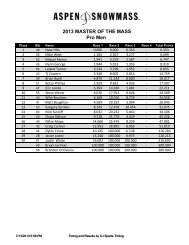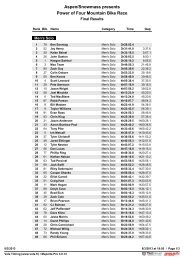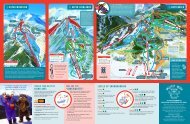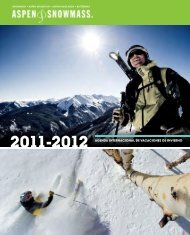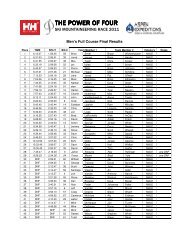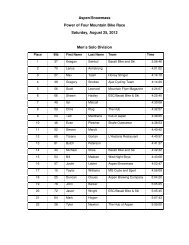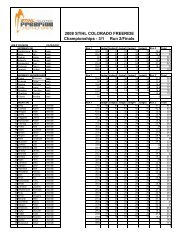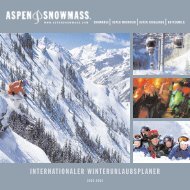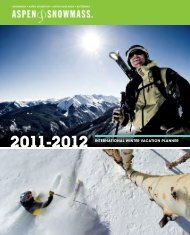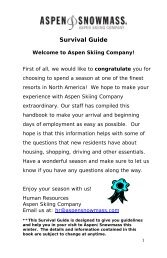LEED is Broken - Aspen/Snowmass
LEED is Broken - Aspen/Snowmass
LEED is Broken - Aspen/Snowmass
Create successful ePaper yourself
Turn your PDF publications into a flip-book with our unique Google optimized e-Paper software.
suggested it would otherw<strong>is</strong>e be an energy hog. The VSD will save lots of money and<br />
tens of thousands of pounds of greenhouse gases. The garage, meanwhile, was designed<br />
to house electric golf carts, whose batteries emit explosive hydrogen gas. Instead of<br />
inefficiently venting heated air 24-7, we installed multiple, redundant hydrogen sensors<br />
creating radical energy savings while safely venting the garage. It was a green design<br />
coup. But since neither the garage nor the kitchen hood ventilation systems were<br />
“regulated loads,” we got no credit for our innovative work, because we’d already used<br />
up all four of <strong>LEED</strong>’s innovation credits. 24<br />
From an operating cost and climate impact perspective, building energy performance <strong>is</strong><br />
critical. That's why hardwired "plug loads" like the ventilation fans described above<br />
matter. In all its energy calculations, <strong>LEED</strong> relies heavily on ASHRAE 90.1. But the<br />
1999 version of th<strong>is</strong> standard fails to provide credit for a number of critical strategies,<br />
including: building orientation and shape, efficient fan systems, low energy pumping<br />
systems, low energy office equipment, efficient exterior lighting, water cooled chillers,<br />
daylight controls, demand controlled ventilation (using CO2 sensors), and high thermal<br />
mass. Some, but not all, of these problems are addressed in ASHRAE’s 2001 version.<br />
These shortcoming are thoroughly described in a must-read article by Jason Mclennan<br />
and Peter Rumsey. 25<br />
Problem # 4: Crippling Bureaucracy<br />
“How long will I have to wait before I can go in to see the major?”— “Just until he goes<br />
out to lunch,” Sergeant Towser replied. — “But he won't be there then, will he?” — “No,<br />
sir. Major Major won't be back until after lunch.”<br />
11<br />
—Joseph Heller, Catch-22<br />
Energy points weren’t the only ones we lost due to <strong>LEED</strong>’s Catch-22 like rules. When<br />
we built our first <strong>LEED</strong> building high above the city of <strong>Aspen</strong> at 11,000 feet, we took<br />
extreme measures to reduce nighttime light pollution, and received an innovation credit<br />
for our labors. Th<strong>is</strong> light pollution credit was later incorporated into <strong>LEED</strong> 2.0.<br />
We assumed that achieving the same credit at the Golf Clubhouse a few years later would<br />
be a no-brainer. But despite the fact that we used the same lighting designer who helped<br />
24 At an adjacent, non-<strong>LEED</strong> building, we ran into a similar ventilation <strong>is</strong>sue. According to ASHRAE,<br />
garages should be vented at 1.5 cubic feet per square foot per minute. Th<strong>is</strong> means using fans to vent air you<br />
just paid to heat. Our engineer found an ASHRAE paper that updated ventilation rates based on cleaner<br />
cars (the old rates were based on ‘65 Mustangs.) That cut the ventilation rate in half. Then he specified CO<br />
monitors, which brought the ventilation rate down even further, saving both fan and heating energy. In<br />
<strong>LEED</strong>, however, th<strong>is</strong> elegant solution would not be eligible for energy credits.<br />
25 Mclennan, J. and P. Rumsey. 2004. “Green Edge: It's Time To Give Credit Where (Energy) Credit Is<br />
Due,” Environmental Building News. May. Available online at<br />
http://www.edcmag.com/CDA/ArticleInformation/features/BNP__Features__Item/0,4120,124654,00.html.<br />
Mclennan and Rumsey: “The USGBC should “move dec<strong>is</strong>ively and quickly to utilize th<strong>is</strong> new energy<br />
standard and help architects and designers get credit where credit <strong>is</strong> due.”



